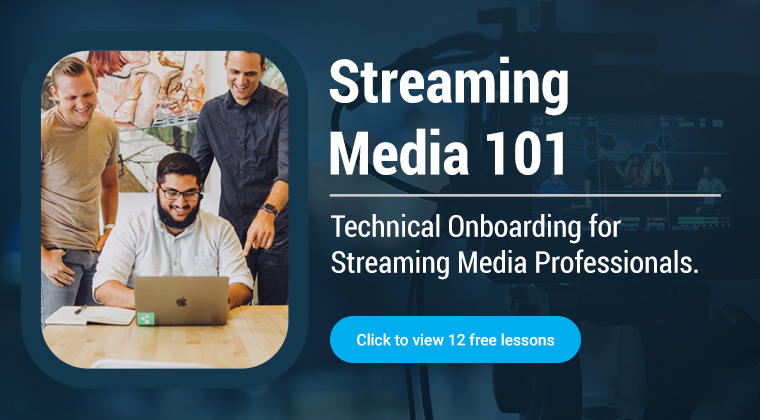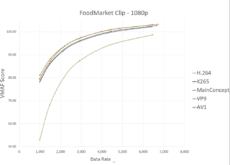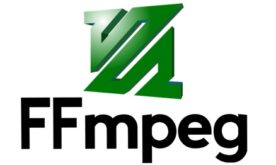Just back from Streaming Media West in Huntington Beach, where I participated in seven presentations over three days. Handouts are up and ready for your download, and the videos are up as well. Three of these presentations, on FFmpeg, HEVC/HLS, and latency, were co-produced by David Hassoun and Jun Heider from the RealEyes consultancy, which serves clients like NBC, ESPN, MLBAM, Adobe, and …
Read More »AV1 No Shows At Streaming Media West; Better in Stockholm?
I’ve been bullish on AV1 since the start, but I’m starting to think the codec is both farther away and less useful than I initially thought. Here’s what’s happening. For Streaming Media East in June 2017, an AV1 member encoded four videos, totaling about 8.5 minutes, to five data rates each for 720p, 1080p, and 4K, and the output quality …
Read More »Download Handout for Reducing Latency and Startup Times
Here’s the description; download the handout below. C203 – How To: Reducing Latency and Startup Times Low latency and fast startup times are KPIs for most streaming video producers, particularly for live events. Though a series of structured tests that measure startup time, latency, and network overhead, this session documents the results achieved by reducing fragment sizes, using hybrid fragment …
Read More »Download Per-Title Encoding Handout
Here’s the description: download handout below: Per-title encoding techniques customize the encoding ladder to match the encoding complexity of the source, saving bandwidth on easy-to-compress videos and ensuring the quality of more complex footage. This session compares the efficiency, implementation issues, and costs of multiple commercially available and open-source alternatives, like Capella Systems Cambria Encoder, compression optimization from multiple vendors, …
Read More »D105 – HOW TO: Comparing AV1, VP9, HEVC, & H.264
Here’s the description; download link below. Many content distributors and aggregators still use H.264 as their primary, if not exclusive codec, but the bandwidth savings incident to newer, more powerful codecs are alluring. Those considering a switch must evaluate at least three options; HEVC, VP9, and the Alliance for Open Media’s AV1 codec, which should be close to release by …
Read More »D103 – HOW TO: Building a More Robust Cloud Encoder With FFMPEG & More
Here’s the video and description; download handout below. With the speed of technology today, one of the most important parts of the software is adaptability. By taking control of your own encoding and packaging, you can greatly reduce cost and maintain high adaptability and agility to meet your needs now and in the future. When working with cloud encoding, there …
Read More »LS101 – Technologies for Live Streaming to Multiple Platforms
Here’s the session description; download the handout below. Streaming to one live streaming service is so 2016. Today, in addition to streaming to your own website or app, you may want to distribute your live stream to multiple other outlets like Facebook Live, YouTube Live, Livestream, Twitter, or Twitch. Fortunately, there are a variety of products and services that enable …
Read More »W4: Encoding Live and VOD for HEVC/HLS
Here’s the description; you can download the handout below. Apple’s support for HEVC in HLS is a ground-breaking event that opens up hundreds of millions of HEVC capable players. If supporting this spec is on your short-term development schedule, you’ll want to check out this workshop. The workshop starts by reviewing the new spec and sharing playback details, like how …
Read More »W2: Encoding 2017: Codecs & Packaging for PCs, Mobile, & OTT/STB/Smart TVs
My first session at Streaming Media West. Here’s the description, you can download the handout below. As video resolutions increase and target playback platforms multiply, video producers must leave their H.264/HLS/HDS comfort zone and expand into HEVC, VP9, and MPEG-DASH. This workshop is divided into multiple segments by target platform to teach you the applicable standards and best strategies for …
Read More »Join Me at Streaming Media West November 1-3
Streaming Media West is coming up on November 1-3 in Huntington Beach, CA, and there are tons of great sessions. I have a bunch of interesting sessions that I wanted to share here. I’ve posted full descriptions below, here are titles and a brief description. Pre-conference Sessions – Wednesday, November 1 I have two pre-conference sessions. 9:00 – 12:00 – …
Read More » Streaming Learning Center Where Streaming Professionals Learn to Excel
Streaming Learning Center Where Streaming Professionals Learn to Excel






